
San Bernardino is a church in Verona, northern Italy. The church, in Gothic style, was built from 1451 to 1466.

San Bernardino is a church in Verona, northern Italy. The church, in Gothic style, was built from 1451 to 1466.
The church's origin are connected to the presence of San Bernardino in the city from 1422, during which he founded a convent of nuns for the order of the Minor Friars and, later, another one for monks. He was canonized in 1450, six years after his death, and in 1451-1452 his successor Giovanni da Capestrano, with the bishop of Verona, Francesco Condulmerio, started the construction of a large complex for the order in Verona, [1] with the support of the Venetian doge Francesco Foscari.
This was consecrated in 1453, though the nave and its ceiling were completed only in 1466. Later a smaller aisle was added. The six bells in E are rung with Veronese bellringing art.
The church has a nave and a single aisle. The simple façade is in brickwork, with a Renaissance portal decorated by three saints figures.
Notable is the collection of Veronese 16th-century paintings in the six chapels of the aisles. The sixth chapel, patronized by the Pellegrini family, was designed by Michele Sammicheli. The main altarpiece depicts a Madonna and Child with St. Anne and Angels (1579), painted by Bernardino India, while the lunette and flanking pictures depict an Eternal Father and Saints Joseph and Young John the Baptist by Pasquale Ottino. [2]
An inventory from 1845 notes that the main altarpiece was by Francesco Bonfiglio. The altars on the left had an altarpiece depicting Saints Margaret of Cortona, Francis of Assisi, and John by Cavaliere Barca and statues of St Roch and Sebastian by Ceschini. The altar of the Nativity had a painting by India. The altar of the Sacred Heart had a work (1819) by Antonio Vicentini. A canvas depicting the Virgin of the Annunciation was over the main portal, painted by Amigazzi. St Peter of Alcantara was depicted on a canvas by Antonio Balestra.
The first chapel on the right is dedicated to St. Francis or of the Terziari, with frescoes by Nicolò Giolfino (1522) with the stories of St. John the Evangelist and St. Francis. The altarpiece depicting the Glory of the Saint was painted by Francesco Morando. The adjacent altar had an altarpiece depicting the Virgen and San Girolamo by Francesco Monsignori. The next chapel dedicated to St Bonaventure, had an altarpiece by Felice Boscarato. The Altar of the Cross had works by Francesco Morando and Francesco Merone in the altar. [3]
The fourth chapel, dedicated to St Antony, has frescoes by Domenico Morone (1511), in poor state. The fifth, includes a Cruficixion by Domenico's son Francesco Morone (1548).
In the sacristy are paintings by Nicolò Giolfino and Paolo Farinata, and lunettes with the Life of Mary painted by Antonio Voltolini. [4]
Frescoes by Domenico Morone and his son Francesco can be found also in a hall of the annexed convent.
Gene P. Veronesi. The decoration of the Sagramossa Library in the Church of San Bernardino, Verona.Ph.D. dissertation, Case Western Reserve University, 2000.

The Church of the Gesù is the mother church of the Society of Jesus (Jesuits), a Catholic religious order. Officially named Chiesa del Santissimo Nome di Gesù, its façade is "the first truly baroque façade", introducing the baroque style into architecture. The church served as a model for innumerable Jesuit churches all over the world, especially in Central Europe and in Portuguese colonies. Its paintings in the nave, crossing, and side chapels became models for art in Jesuit churches throughout Italy and Europe, as well as those of other orders. The Church of the Gesù is located at the Piazza del Gesù in Rome, and is one of the great 17th century preaching churches built by Counter-Reformation orders like the Jesuits in the Centro Storico.

Sant'Andrea della Valle is a titular church and minor basilica in the rione of Sant'Eustachio of the city of Rome, Italy. The basilica is the seat of the general curia of the Theatines and is located on the Piazza Vidoni, at the intersection of Corso Vittorio Emanuele and Corso Rinascimento. It is one of the great 17th century preaching churches built by Counter-Reformation orders in the Centro Storico.

Sant'Anna dei Lombardi,, and also known as Santa Maria di Monte Oliveto, is an ancient church and convent located in piazza Monteoliveto in central Naples, Italy. Across Monteoliveto street from the Fountain in the square is the Renaissance palace of Orsini di Gravina.
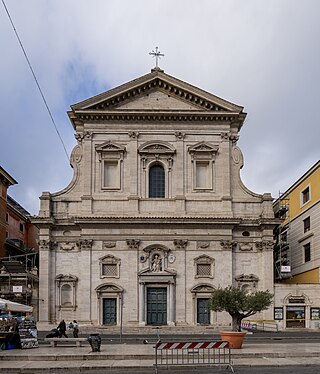
The Church of Santa Maria del Carmelo in Traspontina is a Roman Catholic titular church in Rome, run by the Carmelites. The bridge referred to is the Ponte Sant'Angelo. The church is on the Via della Conciliazione, the primary road of the Roman Rione of Borgo.

Bernardino India (1528–1590) was an Italian painter of the late Renaissance, born and mainly active in Verona.

Domenico Morone was an Italian painter from Verona, painting in an early Renaissance style. Much of his work has not survived, notably his fresco cycles. He was considered by Vasari to be second only to Liberale da Verona among artists in his town. His son Francesco Morone was also a prominent Veronese painter. His pupils included Michele da Verona and Girolamo dai Libri.

The Basilica della Santissima Annunziata del Vastato is the Catholic cathedral of Genoa, northern Italy; its decoration employed the major baroque studios and artists in Genoa in the 17th century.

San Francesco della Vigna is a Roman Catholic church in the Sestiere of Castello in Venice, northern Italy.

San Maurizio al Monastero Maggiore is a church in Milan, Northern Italy. It was originally attached to the most important female convent of the Benedictines in the city, Monastero Maggiore, which is now in use as the Civic Archaeological Museum. The church today is used every Sunday from October to June to celebrate in the Byzantine Rite, in Greek according to the Italo-Albanian tradition. It is also used as a concert hall.

The Chiesa della Santissima Trinità dei Pellegrini is a Roman Catholic church located on Via dei Pettinari #36 In the rione of Regola of central Rome, Italy. It stands a block away from the Palazzo Spada on Via Capo di Ferro, while a few blocks away on the Via dei Pettinari stands the Ponte Sisto.

The church of Sant'Eufemia is a Catholic place of worship located in the heart of Verona's historic center. It straddles an ancient Roman cardo, where a church building probably already existed in the 6th century. The foundation of the present church is owed to the Della Scala family, who brought Augustinian hermit monks to Verona in 1262 so that they could be closer to the community and granted them permission to build a monastery, located at the time in the Capitani quarter of the Scaliger city. Through bequests and donations, particularly that of Alberto della Scala, the building could be consecrated in 1331 by the bishop of Verona Nicolò. The building activity, however, did not end, and in the following years the monastery's rooms continued to be expanded in order to accommodate the increasing number of monks who arrived there attracted by the great prestige the community boasted. A permit granted by Mastino II della Scala in 1340 made it possible to further enlarge the church by building the vast apse that still distinguishes it today. From the end of the fourteenth century work continued on the various chapels and minor altars.
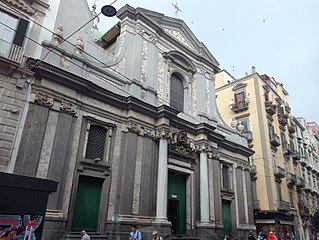
The church of St. Nicholas the Charitable is a church located on via Toledo, almost midway between Piazza Carità and Piazza Dante in Naples, Italy.

The Basilica of San Fedele in Como is located in the city center. The present Romanesque church dates from 1120 and is dedicated to the Fidelis of Como.
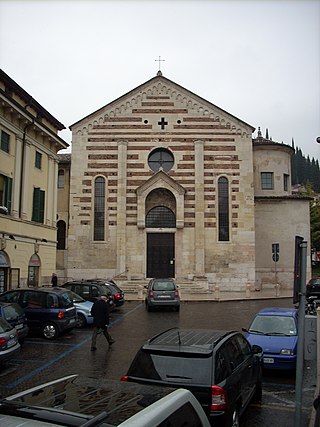
Santo Stefano is a Paleo-Christian, Roman Catholic basilica church in central Verona, region of Veneto, Italy.
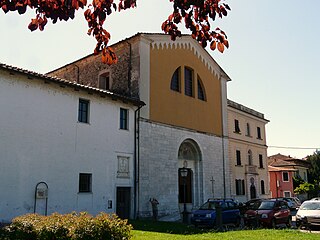
San Francesco is a Roman Catholic church and monastery located in Sarzana, region of Liguria, Italy.
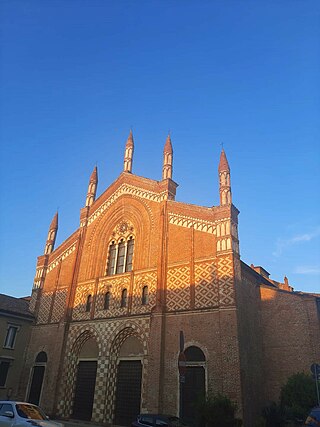
The church of San Francesco of Assisi is a Catholic religious building in Pavia, Lombardy, Italy.

San Pietro is an ancient Roman Catholic church and former monastery located on piazza San Pietro in central Gubbio, region of Umbria, in Italy. The church which displays architectural elements from many centuries, from Romanesque to the Renaissance, as well as housing prominent artworks; the monastery now houses the civic Biblioteca Comunale Sperelliana.
Pietro Paolo Sensini was an Italian painter active in a Mannerist-style painting religious altarpieces mainly in his native city of Todi and nearby towns in Umbria.
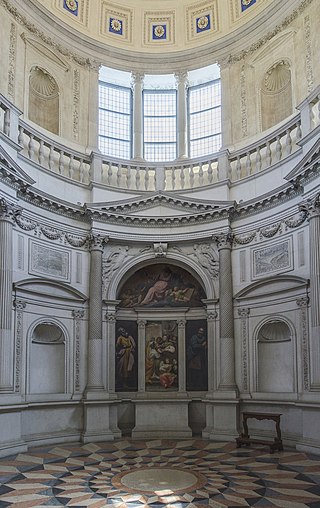
The Pellegrini Chapel, initially named "Guaresco," is a religious building commissioned by Countess Margherita Pellegrini to the famous architect Michele Sanmicheli and built between 1528 and 1559. It occupies a prominent place in Renaissance architecture.

San Vincenzo is a Baroque style, Roman Catholic church, now deconsecrated, located at Via Scalabrini #6 in the South-East quadrant of Piacenza, Region of Emilia Romagna, Italy. The church was restored starting in 2009 for use as an auditorium and to host concerts.